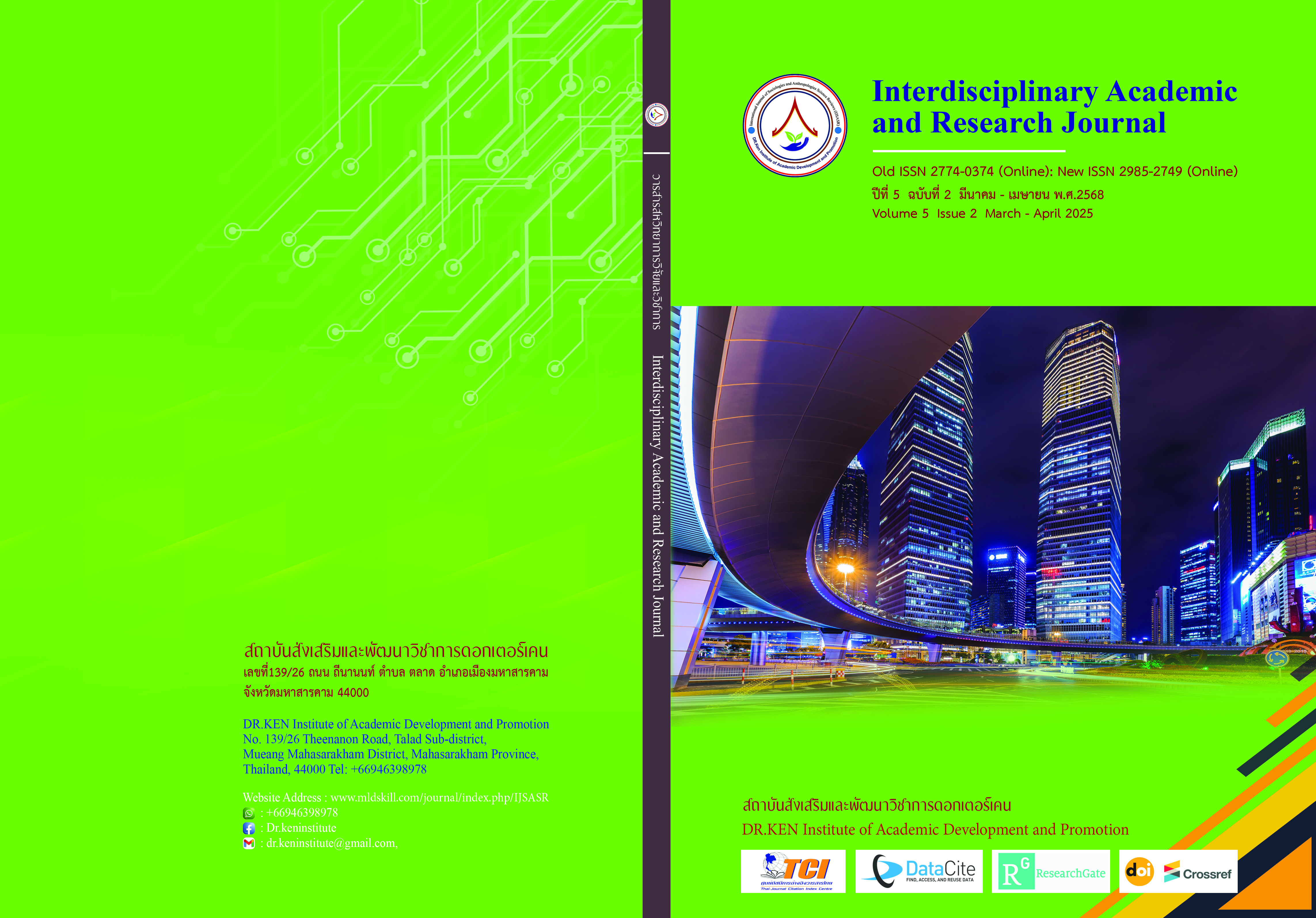The Probability of Viewing Decisions on Fitness and Health Channels on Social Media Platforms among Generation Z in Thailand: The Role of Influencer Marketing and Influencer Live-Streaming
DOI:
https://doi.org/10.60027/iarj.2025.281617คำสำคัญ:
Influencer Marketing, Influencer Live-streaming, Viewing Decision, Fitness Contentบทคัดย่อ
Background and Aims: Generation Z is highly engaged with social media platforms like YouTube, Instagram, and TikTok, making them a key target for influencer marketing, particularly within the fitness content niche. This study aims to investigate how influencer marketing and live-streaming impact Generation Z's viewing decisions across these platforms. Given the growing influence of social media on health-related behaviors, this research fills a gap by examining these effects in Thailand, where few studies have explored this relationship.
Methodology: The study employed a purposive sampling method to collect data from 253 young adults in Thailand with experience in social media commerce and fitness content consumption. Logistic regression analysis was used to assess the influence of two independent variables—influencer marketing and live-streaming—on the likelihood of viewing fitness content across YouTube, Instagram, and TikTok.
Results: Influencer marketing significantly increased the likelihood of viewing fitness content on all platforms, with odds ratios between 1.99 and 3.13. On the other hand, live-streaming did not show a significant effect on YouTube or Instagram, while on TikTok, it hurt viewing decisions, with an odds ratio of 0.505. This unexpected result suggests platform-specific behaviors.
Conclusion: The study highlights the strong influence of influencer marketing on fitness content engagement among Generation Z and the more complex role of live-streaming. These findings offer actionable insights for marketers and contribute to existing literature by exploring region-specific behaviors in Thailand, paving the way for future research on platform-specific influencer strategies.
เอกสารอ้างอิง
Box, G. E. P., & Tidwell, P. W. (1962). Transformation of the independent variables. Technometrics, 4(4), 531–550. https://doi.org/10.2307/1266288
Brown, A., & Lee, M. (2022). The role of live-streaming in influencer marketing: Engaging Gen Z with fitness content. Journal of Digital Marketing, 35(2), 115-127. https://doi.org/10.1016/j.digmkt.2022.04.005
Chen, L. (2022). The role of live-streaming in influencer marketing. Journal of Digital Marketing, 15(3), 45-60.
Chen, Y. (2022). The impact of live-streaming on health communication: A case study of wellness influencers. Journal of Digital Health, 15(2), 145-160.
Chen, Y. (2023). Real-time engagement through live-streaming: A new frontier for fitness influencers. Social Media Studies, 42(3), 187-198. https://doi.org/10.1080/1369118X.2023.1210398
Chou, P., Lee, K., & Wang, H. (2022). Impact of social media influencers on health behavior: A focus on Generation Z. Journal of Health Communication, 27(1), 45-60. https://doi.org/10.1080/10810730.2022.1981725
Cialdini, R. B., & Goldstein, N. J. (2004). Social influence: Compliance and conformity. Annual Review of Psychology, 55(1), 591-621. https://doi.org/10.1146/annurev.psych.55.090902.142015
CivicScience. (2022). Gen Z fitness trends & statistics: 7 health trends among Gen Z. CivicScience. https://civicscience.com/gen-z-fitness-trends-statistics
Dixon, S. J. (2023). Share of Generation Z internet users in selected countries who use social media as of 2023. Statista. https://www.statista.com/statistics/1446950/gen-z-internet-users-social-media-use/
Fairhurst, A. (2023). Visual aesthetics in influencer marketing: Instagram’s role in promoting fitness content. Journal of Visual Communication, 29(1), 33-49. https://doi.org/10.1080/1477596X.2023.1145192
Fairhurst, K. E. (2020). A phenomenological photovoice exploration of female exercisers' experiences of their body in fitness center environments. Master's Thesis: Virginia Commonwealth University. https://doi.org/10.33915/ETD.7546
Field, A. (2013). Discovering statistics using IBM SPSS Statistics. (4th ed.). SAGE Publications.
Freberg, K., Graham, K., McGaughey, K., & Freberg, L. (2011). Who are the social media influencers? A study of public perceptions of personality. Public Relations Review, 37(1), 90-92. https://doi.org/10.1016/j.pubrev.2010.11.001
Hair Jr., J. F., Matthews, L. M., Matthews, R. L., & Sarstedt, M. (2017). PLS-SEM or CB-SEM: Updated guidelines on which method to use. International Journal of Multivariate Data Analysis, 1(2), 107-123.
Hair, J. F., Ringle, C. M., & Sarstedt, M. (2013). Partial least squares structural equation modeling: Rigorous applications, better results, and higher acceptance. Long Range Planning, 46(1-2), 1-12. https://doi.org/10.1016/j.lrp.2013.01.001
Huang, O., & Copel, L. (2020). Gen Z, Instagram influencers, and hashtags' influence on purchase intention of apparel. Academy of Marketing Studies Journal, 24(1), 1-15.
Hwang, J., & Zhang, C. (2023). The influence of authenticity in fitness influencer marketing: Applying Social Influence Theory. International Journal of Social Media and Influencer Marketing, 6(4), 62-75. https://doi.org/10.1108/IJSMIM-05-2023-0028
Hwang, J., & Zhang, Q. (2018). The impact of social media influencers on purchasing decisions: The mediating role of consumer trust. Journal of Retailing and Consumer Services, 43, 1-11. https://doi.org/10.1016/j.jretconser.2018.01.008
Johnson, R., & Lee, S. (2022). Trust and credibility in influencer marketing: A Gen Z perspective. International Journal of Marketing Studies, 14(2), 112-128.
Johnson, R., & Lee, T. (2022). Influencer authenticity and viewer motivation in health content. International Journal of Health Communication, 27(4), 321-335.
Katz, E., & Lazarsfeld, P. F. (1955). Personal influence: The part played by people in the flow of mass communications. Free Press.
Kim, T. (2023). Content types and viewer engagement among Generation Z. Journal of Social Media Research, 10(1), 25-38.
Likert, R. (1932). A technique for the measurement of attitudes. Archives of Psychology.
Martinez, R. (2023). Pre-video content marketing strategies: Influencer collaborations and their impact on Gen Z engagement. Marketing Insights Quarterly, 19(2), 78-88. https://doi.org/10.1108/MIQ-04-2023-0035
Mayoh, J., & Jones, I. (2020). Young people’s experiences of engaging with fitspiration on Instagram: A gendered perspective. Journal of Medical Internet Research, 22(8), e17811. https://doi.org/10.2196/17811
McKinsey & Company. (2024). Mind the gap: Gen Zers are obsessed with wellness. McKinsey & Company. https://www.mckinsey.com/industries/consumer-packaged-goods/our-insights/mind-the-gap-gen-zers-are-obsessed-with-wellness
Milam, A. J. (2023). Consumer engagement with fitness influencers on YouTube. In Proceedings of the International Conference on Digital Marketing (pp. 55-70). https://doi.org/10.1007/978-981-19-9099-1_26
Nazarov, V. (2023). TikTok’s algorithmic success: Personalized feeds and engagement in Gen Z fitness content. Social Media Review, 9(1), 25-40. https://doi.org/10.1177/0894439323113120
OOSGA. (2023). Social media usage in Thailand. OOSGA. https://oosga.com/social-media/tha/
Ratner, B. (2009). The correlation coefficient: Its values range between +1/−1, or do they? Journal of Targeting, Measurement and Analysis for Marketing, 17(2), 139–142. https://doi.org/10.1057/jt.2009.5
Ratwatte, R., & Mattacola, J. (2023). Long-form fitness content on YouTube: The evolution of fitness influencers. Journal of Health and Social Behavior, 64(1), 72-88. https://doi.org/10.1177/0022146523110016
Shi, Y., & Chung, H. (2022). Uses and gratifications of short-form video content: TikTok's role in Gen Z fitness engagement. Media Psychology, 24(3), 211-228. https://doi.org/10.1037/med0000394
Smith, J. A., & Fieldsend, M. (2021). Interpretative Phenomenological Analysis. In P. M. Camic (Ed.), Qualitative Research in Psychology: Expanding Perspectives in Methodology and Design (pp. 147-166). American Psychological Association.
https://doi.org/10.1037/0000252-008
Turner, R. C., & Carlson, L. (2003). Indexes of item-objective congruence for multidimensional items. International Journal of Testing, 3(2), 163-171. https://doi.org/10.1207/S15327574IJT0302_5
Zilka, G. C. (2023). Gen Z self-portrait: Vitality, activism, belonging, happiness, self-image, and media usage habits. Issues in Informing Science and Information Technology, 20, 83-96. https://doi.org/10.28945/5139
ดาวน์โหลด
เผยแพร่แล้ว
รูปแบบการอ้างอิง
ฉบับ
ประเภทบทความ
สัญญาอนุญาต
ลิขสิทธิ์ (c) 2025 Interdisciplinary Academic and Research Journal

อนุญาตภายใต้เงื่อนไข Creative Commons Attribution-NonCommercial-NoDerivatives 4.0 International License.
ลิขสิทธิ์ในบทความใดๆ ใน Interdisciplinary Academic and Research Journal ยังคงเป็นของผู้เขียนภายใต้ ภายใต้ Creative Commons Attribution-NonCommercial-NoDerivatives 4.0 International License การอนุญาตให้ใช้ข้อความ เนื้อหา รูปภาพ ฯลฯ ของสิ่งพิมพ์ ผู้ใช้ใดๆ เพื่ออ่าน ดาวน์โหลด คัดลอก แจกจ่าย พิมพ์ ค้นหา หรือลิงก์ไปยังบทความฉบับเต็ม รวบรวมข้อมูลเพื่อจัดทำดัชนี ส่งต่อเป็นข้อมูลไปยังซอฟต์แวร์ หรือใช้เพื่อวัตถุประสงค์ทางกฎหมายอื่นใด แต่ห้ามนำไปใช้ในเชิงพาณิชย์หรือด้วยเจตนาที่จะเป็นประโยชน์ต่อธุรกิจใดๆ

















